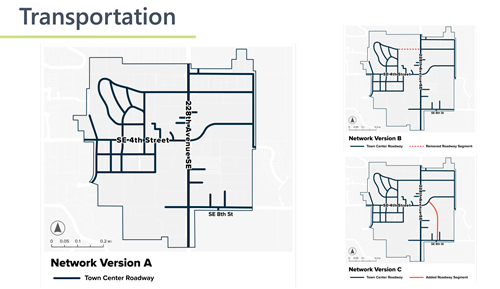Town Center Potential Impacts - Traffic
The Town Center Plan updates under consideration includes investments in new local street grids, intersection improvements, expanded sidewalks, safer bike lanes, and multimodal options to mitigate higher traffic volumes in, through and around Town Center. Increases in housing density enhance the viability of transit long-term.
How does the City plan transportation in Sammamish?
Learn more about how the City manages and plans for transportation now and for the future by going to the Transportation Planning page.
See also Transportation Planning Frequently Asked Questions.
How will development in Town Center impact traffic?
Analysis has shown that as Town Center is developed, traffic impacts would fall within the City's adopted level of service. That's because of improvements that will be made alongside development.
All projects are evaluated at permit stage through concurrency requirements. Based on the current rate of growth, it would take over 50 years to build 4,000 housing units. Even if Town Center was fully built in half that time, this is easily manageable and provides a reasonable timeline to plan for, fund, and construct infrastructure.
Click the image below to view the Transportation section of the Final SEIS presentation:
View the full Final SEIS presentation.
New connector roads in Town Center help address 228th corridor congestion
One of the most frequent comments we hear is around delays and inconveniences associated with traffic on the segment of 228th Ave between Discovery Elementary and Northeast 8th Street/Inglewood Hill Road, generally associated with school schedules and lack of transportation network options. The proposed addition of connector roads within Town Center will provide alternative routes and reduce the number of trips and turning movements through key congestion points, primarily 228th/8th Southeast and 228th/4th Southeast. The addition of new connector streets, such as Southeast 1st, Southeast 6th, 224th, 230th, and 232nd with important intersection reconfigurations will provide parallel and alternative travel routes.
Who will pay for improvements?
As with all developments within the city, the developer pays for all infrastructure to serve their project. The city may step in to fill off-site gaps in infrastructure where needed. This is paid for by impact fees and is the intended use of impact fees. The Town Center has produced nearly $5 million in street impact fees and over $1 million in park impact fees. In either build-out scenario, the Town Center will continue to collect millions of dollars in impact fees that will help fund developing, expanding, and improving the roads, parks, and schools that support its growth.

